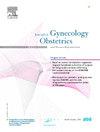产程第二阶段胎儿心率的哪些变化与新生儿酸中毒有关?
IF 1.6
4区 医学
Q3 OBSTETRICS & GYNECOLOGY
Journal of gynecology obstetrics and human reproduction
Pub Date : 2025-09-30
DOI:10.1016/j.jogoh.2025.103043
引用次数: 0
摘要
目的:探讨产程第二阶段与新生儿酸中毒相关的胎儿心率(FHR)模式。方法:该单中心(法国里尔)回顾性队列研究于2022年9月至2023年1月进行。对所有妊娠37周后顺产的低风险妇女进行排尿时的胎儿心率(FHR)分析。低风险定义为没有任何产妇史,产科并发症,在开始排尿前一小时胎儿心率正常。基线增加被定义为基线FHR增加超过20%。减少可变性和显著可变性分别被定义为小于5 bpm和大于25 bpm的可变性。fhr也根据Melchior的分类进行了描述。结果:在分析的275例驱逐fhr中,7.3%(20/275)显示基线升高,5.5%(15/275)显示异常变异性。新生儿酸中毒发生率为19.6%(54/275)。基线增高和心动过缓与新生儿酸中毒显著相关(分别为14.8%对5.4%,p=0.035和20.4%对10.0%,p=0.035)。结论:产程第二阶段胎儿基线心率升高与新生儿酸中毒风险显著相关。将其纳入与此阶段相关的分类将是有趣的。本文章由计算机程序翻译,如有差异,请以英文原文为准。
What changes in the fetal heart rate are associated with neonatal acidosis during the second stage of labor?
Objective
To describe fetal heart rate (FHR) patterns associated with neonatal acidosis during the second stage of labor.
Method
This single-center (Lille, France) retrospective cohort study was conducted between September 2022 and January 2023. Fetal heart rate (FHR) during maternal expulsive efforts was interpreted for all low-risk women who delivered vaginally after 37 weeks' gestation. Low risk was defined by the absence of any maternal history, obstetric complications, and a normal fetal heart rate in the hour before the onset of expulsive efforts. A baseline increase was defined as a greater than 20 % increase in baseline FHR. Reduced variability and marked variability were defined as a variability <5 bpm and greater than 25 bpm, respectively. FHRs were also described according to Melchior's classification. Neonatal acidosis was defined as umbilical artery pH <7.15.
Results
Among the 275 expulsion FHRs analysed, 7.3 % (20/275) showed increased baseline and 5.5 % (15/275) abnormal variability. Neonatal acidosis occurred in 19.6 % (54/275) of neonates. Increased baseline and bradycardia were significantly associated with neonatal acidosis (14.8 % vs 5.4 %, p = 0.035 and 20.4 % vs 10.0 %, p = 0.035, respectively).
Conclusion
Increased baseline fetal heart rate during the second stage of labor was associated with a significant risk of neonatal acidosis. It would be interesting to include it in classifications related to this stage.
求助全文
通过发布文献求助,成功后即可免费获取论文全文。
去求助
来源期刊

Journal of gynecology obstetrics and human reproduction
Medicine-Obstetrics and Gynecology
CiteScore
3.70
自引率
5.30%
发文量
210
审稿时长
31 days
期刊介绍:
Formerly known as Journal de Gynécologie Obstétrique et Biologie de la Reproduction, Journal of Gynecology Obstetrics and Human Reproduction is the official Academic publication of the French College of Obstetricians and Gynecologists (Collège National des Gynécologues et Obstétriciens Français / CNGOF).
J Gynecol Obstet Hum Reprod publishes monthly, in English, research papers and techniques in the fields of Gynecology, Obstetrics, Neonatology and Human Reproduction: (guest) editorials, original articles, reviews, updates, technical notes, case reports, letters to the editor and guidelines.
Original works include clinical or laboratory investigations and clinical or equipment reports. Reviews include narrative reviews, systematic reviews and meta-analyses.
 求助内容:
求助内容: 应助结果提醒方式:
应助结果提醒方式:


